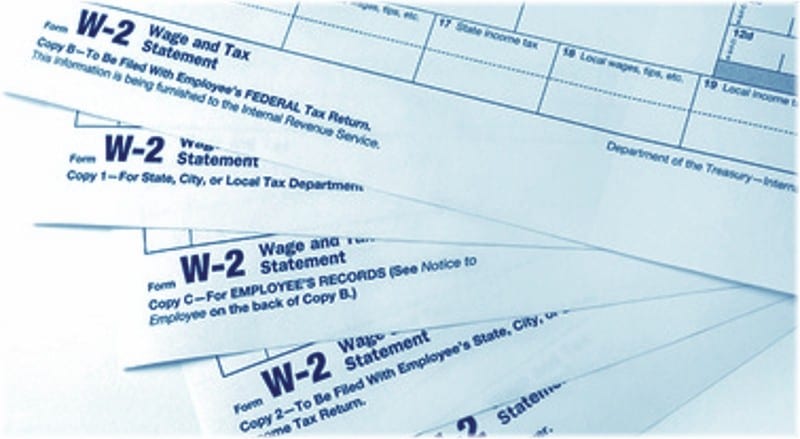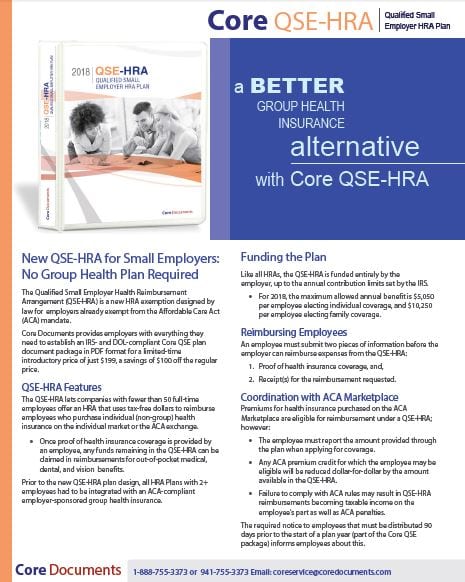Home / Blog / How to report QSEHRA benefits on Form W-2 and exceptions
How to report QSEHRA benefits on Form W-2 and exceptions
The IRS requires employers to report QSEHRA benefits on Form W-2 for QSEHRA benefits available to employees. This amount must be reported on every employee’s W-2 whether or not the employee receives reimbursement from the QSEHRA. Employees may not waive QSEHRA coverage but having its availability reported on Form W-2 will not have an effect on the employee’s taxable income either way.

How to report QSEHRA benefits on Form W-2
The Qualified Small Employer Health Reimbursement Arrangement (QSEHRA) is a fairly new HRA plan design, available to employers since December 2016. With a QSEHRA, employers with fewer than 50 full-time employees can provide funds to help employees buy individual health insurance with pre-tax dollars, as long as the employer provides no group health plan to any active employee group.
Recent guidance (Notice 2017-67) provides details on the basics for reporting QSEHRA benefits on Form W-2, plus how to report variances that can come up in some employee-employer situations.
Standard Permitted Benefits in QSEHRA
The entire amount of the QSE-HRA benefit available to the employee must be reported on Form W-2 whether or not the employee uses it.
This amount is reported in box 12, using code FF. This is a new code especially for the QSE-HRA benefit amount available to the employee. The IRS description for it is, “Permitted benefits under a qualified small employer health reimbursement arrangement.” It is not counted as taxable income for the employee.
Over-the-Counter Medical Expenses
An employer may choose to allow reimbursement of over-the-counter medical expenses (eligible per Publication 502) through the QSEHRA. When this option is made available to employees, records must be kept for year-end W-2 reporting.
When an employee receives reimbursement from the QSEHRA for over-the-counter drugs:
- The amount is reported on Form W-2 as income in box 1 as well as box 3, Social Security wages, and box 5, Medicare wages.
Non-Calendar Plan Years
When a QSEHRA is run on a non-calendar plan year, the amount reported on Form W-2 is pro-rated accordingly.
For example, an employer provides a QSEHRA with a plan year of July 1 to June 30:
For the plan year beginning July 1, 2017, a QSEHRA benefit of $4,000 was available to every employee for July 1, 2017 through June 30, 2018. The amount reported on the employee’s 2017 Form W-2, box 12, code FF is $2,000 (for July-December 2017).
In the new plan year (2018), the QSEHRA provides $4,500 to every employee for July 1, 2018 through June 30, 2019. The amount reported on the employee’s 2018 Form W-2, box 12, code FF is $4,250 ($2,000 for January-June 2018, and $2,250 for July-December 2018).
Carryover Provisions
When a QSEHRA has a carryover provision, the amount reported on Form W-2 for a calendar year includes only newly available funds.
For example, the employer allows a full carryover of unused funds from the previous plan year. An employee has $2,000 remaining in his QSEHRA allowance for 2017. In 2018, he receives the full $4,000 for that year. Only the $4,000 in new funds will be reported on his 2018 Form W-2 in box 12 (code FF).
Employee Waiver of Participation
According to Question 11 of IRS Notice 2017-67, employees may not decline QSEHRA participation and thereby avoid W-2 reporting of funds available. This is because the rules governing the QSEHRA say that an eligible employer must provide, rather than offer, a QSEHRA on the same terms to all eligible employees. Since it is provided, it is there. It is not an offer that may be accepted or refused.
The good news is, the QSEHRA amount reported in Box 12 (code FF) is not reported as income but as a ‘permitted benefit.’ It has no impact on an employee’s tax situation, for better or worse.
IMPORTANT: When an employee’s MEC coverage lapses for any month of the year
An employer may not reimburse funds from a QSEHRA without receiving proof of MEC with the employee’s initial attestation for the first reimbursement requested. Later reimbursements also require written attestation from the employee plus proper substation of expenses for each claim.
If an employer mistakenly issues a QSEHRA reimbursement and then later learns that the employee did not have MEC for the period in which the reimbursed expense occurred, or if the substantiation for that particular expense is later found to be inadequate, the employee must repay the reimbursement as soon as possible but no later than March 15 of the plan year following the improper distribution.
However, if W-2 reporting is required before the employee has repaid the amount, that amount is taxable to the employee.
- The amount must be included in the employee’s gross income on Form W-2, box 1.
- The amount is not subject to FICA tax and should not be included in box 3, Social Security wages, or box 5, Medicare wages.
If the employee does not repay the amount by March 15 of the following year, the QSEHRA may fail to meet guidance standards. A QSEHRA may not, under any circumstances, reimburse any medical expenses, insurance premiums or otherwise, to an employee that does not have and provide evidence of MEC.
Conclusion
The QSEHRA is an excellent benefit choice for small employers (< 50 employees) with no other group health plan for active employees. It is important to follow IRS guidance for reporting QSEHRA employee benefits on Form W-2 at the end of each tax year. For more information on the QSEHRA and guidance received from the IRS, please read our other blog posts on the topic:
PCORI fee on some HRA/FSA plans (includes QSEHRA)
What is proof of MEC for QSEHRA eligibility? (with attestation forms)
QSEHRA reimbursement to employees without health insurance
QSEHRA Guidance: Eligibility, Terms, Limits and Notice Requirement (Part 1 of 3)
QSEHRA Guidance: Coverage, Reimbursement, Reporting, and Marketplace Coordination (Part 2 of 3)
QSEHRA Guidance: Failure to Satisfy, HSA Interaction, and Effective Date (Part 3 of 3)
QSEHRA: The Stand-Alone HRA Returns — Plan Documents Just $199
Free QSE-HRA Brochure and Forms

Click to download